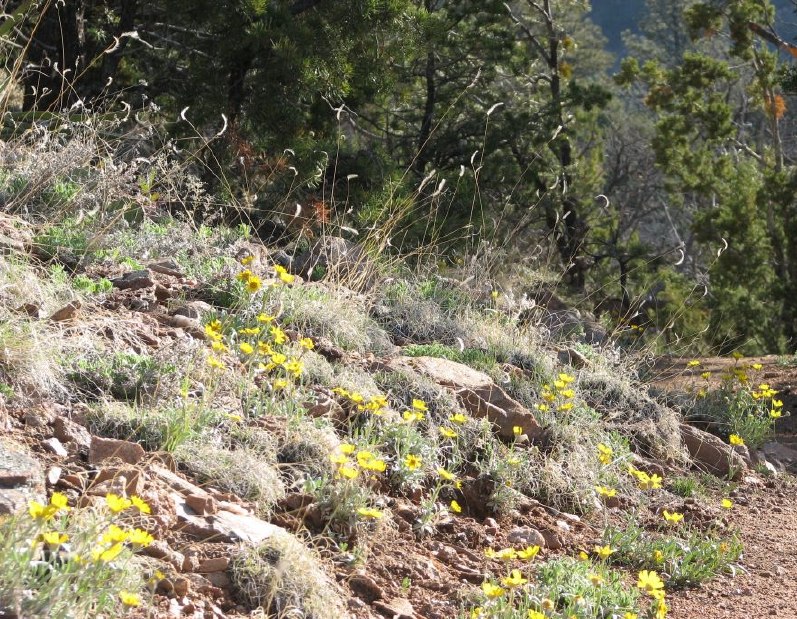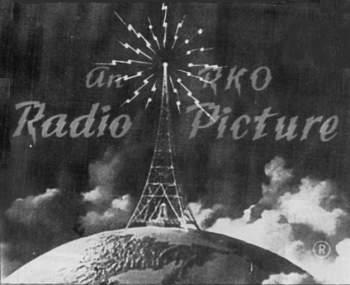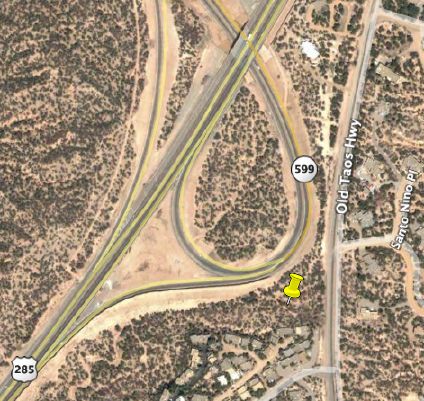

copyright 2007 by George Johnson

hymenoxys argentum, photo by George Johnson, copyright 2007
1. Retrofit Arithmetic (and Rainbarrel Economics)
2. The San Juan-Chama Shell Game
3. The Case of the Disappearing Aquifer
4. The Creative Hydrology of Suerte del Sur
5. The City, the County, and a Water Tax Revolt
6. Water Numerology at City Hall
(Our story thus far)
7. The Woman at Otowi Gauge
8. "Forget it, Jake. It's Chinatown."
9. The Las Campanas Connection
(Our story continues)
10. The Engineering Solution
May 3, 2007
41. Invasion of the Spa People
Sunday morning as I hiked to the top of Talaya Peak ("Picacho," it's called for short) I thought about a recent quote in the New Mexican from the city's new $116,000-a-year marketing director, a man named Keith Toler:
It's going to be a great opportunity for me. I'm looking forward to having a product like Santa Fe to take to market.
From where I was walking, Santa Fe seemed like an easy sell. Water was flowing in the upper reaches of the Arroyo Mora, running down toward Apodaca Hill Road and the Santa Fe River. The southwestern slopes of Talaya were bursting with one of my favorite wildflowers, hymenoxys argentum (whose irritating nickname, "Perky Sue," prompted me to learn the Latin). In a few weeks will come the violet stars of phlox nana (Santa Fe phlox) and the deep red blossoms of claret-cup cactus.
But these kinds of amenities are apparently not what is in demand. "Let's face it, people are stressed out in their daily lives," Mr. Toler went on to say. "They're looking for leisure-time activities, and the greatest disposable income is with the baby boomers. Baby boomers are very much spa people -- 'Let's make it about me' -- and that's going to be very important."
In promoting Santa Fe as what a city news release called "a premier tourist destination," Mr. Toler has his work cut out for him. Come to Santa Fe, where a breakdown in policing has led to a doubling in the burglary rate. Where on a quiet May evening carloads of gang thugs arrive at a neighborhood park and shoot into a group of teenaged soccer players, sending two to the hospital. Where just two days earlier (as I blissfully hiked the Dale Ball trails) neighbors near another suburban park found a body on the sidewalk -- a 29-year-old-man stabbed in the neck apparently during a drug deal. Where around the same time in the Guadalupe District a woman was raped in her home by an intruder who may be responsible for half a dozen similar assaults.
As the spa people, lured by a $2.5 million public relations campaign, relax on the massage tables and, fresh from the sauna, have their nails done, they probably won't notice the alarming headlines. But if they leave the hotel they'll encounter evidence of the chronic petty crime that criminologists take as a sign of deeper trouble: The graffiti sprayed on adobe walls and etched on windows and traffic signs. The Budweiser bottles, Jack Daniel miniatures, and empty 12-packs littering the streets. The hostile drivers with their deafening boom boxes cruising the Plaza, broadcasting contempt for everyone but themselves.
It will take more than a facial to turn this troubled little city into a saleable "product." The most powerful publicity is word of mouth. You can buy all the ads you like, but illusions can be sustained for only so long.
May 6, 2007
The Sunday Papers
With the possible exception of Española businessman Richard Cook, who destroyed the once scenic village of Velarde with his gravel operation, the worst despoilers of the northern New Mexico landscape are cell phone towers -- from the sky blue monstrosity atop La Bajada, brought to us courtesy of the Budagher family, to the even more hideous cluster Nambe Pueblo imposed on Cuyamungue. But ugly as they are, there is no scientific evidence that they pose a health threat.

As noted here before, a tiny number of much disputed studies suggests that holding a cellphone to your head for hours on end might not be good for your brain. (Please see Blinded by Pseudoscience and What Science Really Knows About Wifi.) But that's about it. Given the preponderance of research showing that atmospheric electromagnetism is harmless, it is irresponsible for the New Mexican to run an uncritical report like the one today by Julie Grimm.
Without providing a shred of context, the story begins with the unsubstantiated pronouncements of a holistic healer and professional detoxifier named Dietrich Klinghardt, who told the World Congress of Integrated Medicines, which met last week at the Eldorado Hotel, that the danger from electromagnetic waves is "bigger than anything we've dealt with in medicine," and that it induces infantile autism. Other speakers, we are credulously informed, "said cell phones and wireless technology are the cause of myriad disorders including cancer, insomnia, fatigue, immune system problems, low sperm count and high blood pressure."
The agenda for the meeting, which the New Mexican treated as a major scientific event, also included presentations on "Bound Lotus Healing: Inward and Outward Healing Secrets of the Ancient Yogis," "Homeopathy & the Alchemical Imagination," and the usual spate of New Age quackery -- Feng Shui, sound healing, colonic therapy, iridology, herbal cures.
Ms. Grimm, one of the New Mexican's best reporters -- she won five first-place awards last week -- would never write such an uninformed story about county politics. The New Mexican owes its readers a followup report, based on science instead of superstition.

Journal North reprinted my piece on the invasion of the spa people. In the same section is a nice op-ed by Russell Simon, who returned from a recent vacation to Europe struck by how far behind Santa Fe is in preserving its history while remaining a living town.
They have persistently vibrant city centers traveled more by locals than tourists. They have preserved a stunning collection of architecture with styles spanning centuries and even millennia. They have coherent urban neighborhoods sprinkled with well-used parks and open space. They have more bike lanes and walking paths than Americans typically think possible. And they have some of the best orchestras and museums in the world, and some of the best food, though no green chile.
Meanwhile efforts continue to convert what's left of downtown Santa Fe into a shopping mall.
May 10, 2007
Both the New Mexican and the Journal got the facts right, but the constraints of daily newspaper journalism don't allow for the subtext that would have told readers what really happened last night at City Hall.

Casting himself as a champion of affordable housing, developer Kurt Young and his agent Jennifer Jenkins (if the names are unfamiliar please plug them into the search box at the bottom of this page), managed to turn what should have been a straight-forward land-use decision by the Council into a racial confrontation. Stuck with a two-acre armpit of land, eroded by arroyos and wedged between Old Taos Highway and the bypass offramp for U.S. 84/285, Mr. Young and his Albuquerque investors have been pushing to have it rezoned: instead of two houses they want to build a 19-unit condominium complex. Packing the hall with residents from the southside, the westside (including former mayor Debbie Jaramillo), and out of town, the developers spun the illusion that this wasn't about multiplying their profits but providing housing for blue-collar families.
Never mind that in truth only five of the condos would, as required by law, be affordable (two more semi-affordable units were thrown in to sweeten the deal). Never mind that the city's crying need for affordable housing on the north side will soon be addressed in a meaningful way by the Northwest Quarter plan. Never mind that after a thorough review of the steep, marginally developable terrain, the city's land-use staff recommended against the request, which requires not just a rezoning but an amendment to the General Plan. Intimidated by the insinuation that a vote against Mr. Young was a vote against social justice and the future of Santa Fe, the council approved the project 5-3.
This self-serving manipulation of an important issue -- Santa Fe desperately needs to increase middle-class homeownership all over town -- will come as no surprise to those who remember the 2004 Santa Fe Grassroots affair. Mr. Young, serving as front man for some of the biggest money interests in town, helped run the sleaziest campaign in modern Santa Fe history. Using anonymous post office boxes, misspellings, and other obfuscations to disguise the source of the money, big-time real estate investors -- Greer Enterprises, Phase One Realty, Thornburg Inc. -- quietly backed Council candidates Carmichael Dominguez, Eric Lujan, and Rick Berardinelli. Though the first two lost that election, Mr. Dominguez, all forgiven, came back to win a seat in 2006.
Last night, he and Mr. Ortiz sided with Mr. Young and were joined by Ronald Trujillo and even Miguel Chavez -- one of the targets three years ago of a Grassroots smear job. Councilors Calvert, Bushee, and Heldmeyer, along with Mayor Coss, stood up against the ruse, but Rebecca Wurzburger, an old hand at playing the affordable housing card for the benefit of her developer friends, provided the remaining vote needed by Mr. Young.
Not since last July, when developers used the same brand of populist demagoguery to maintain control over the Planning Commission, has there been so cynical a demonstration of how this town's ethnic tensions can be exploited to the detriment of us all. Watch your back. Santa Fe Grassroots rides again.

May 14, 2007
Postscript
Councilor Ortiz has written to object to my lumping him in as a beneficiary of Santa Fe Grassroots. When I originally wrote about the many irregularities of the 2004 election, I distinguished between him and the trio, Dominguez/Lujan/Berardinelli, that was backed by the orchestrated efforts of Santa Fe developers. While Mr. Ortiz did receive money from principals of Phase One Realty, which is involved with the development of the Thornburg project (please see Part 17. The Rooming House at 346 Calle Loma Norte), his campaign was not supported by the expensive PR blitz and attack ads produced by the Grassroots machine.
I think it is fair to point out that Mr. Ortiz was far from outraged by the Grassroots affair, joining Councilor Wurzburger in trying to block an investigation. But referring to him as a beneficiary of Kurt Young, as I originally did in my post of May 10, was brushing with too broad a stroke. He is a much more complicated man.
May 17, 2007
Wi Fi Fo Fum
A short piece in this week's Reporter on the wireless Internet "controversy" is a big improvement over the embarrassing take in the New Mexican. But it also serves as a textbook example of the distortions that can arise when a journalist assumes that there are always two sides to a story. "The scientific community," we're told, "is largely split about what, if any, health consequences come as a result of Wi-Fi and even cellular phones." That is like writing that medical researchers are "largely split" on whether HIV causes AIDS. The implication is that there is a rough parity of opinion when in fact only a few mavericks have speculated, with no data to back them up, that the extremely weak signals from wifi might induce measurable physiological effects.
Balanced like a circus seal on a beach ball, the story goes on to provide quotes from precisely two people on each side of the issue. The most sensible comes from Steve Ross, described as a "trained physicist" (as opposed, I guess, to one who is self-taught) and editor of Broadband Properties Magazine:
I do not dismiss the potential for health effects. We literally don't know the health effects. I do dismiss almost all of the studies that I've seen, but that doesn't mean we shouldn't keep doing them.
What we do know is that the preponderance of evidence has alleviated most experts' concerns over cell phones -- and wifi is much weaker. (It takes three separate transmitters to get around the adobe and plaster walls in my house.)
Wireless users of all kinds can take comfort in the inverse square law. The signal put out by the wifi station under my desk is about 300 milliwatts (thousandths of a watt) -- 200 times weaker than a 60-watt light bulb. That's roughly how much microwave radiation my brain would receive if I slept with the device under my pillow, an inch from my head, while it downloaded videos all night. If I moved 10 inches away the intensity would drop a hundredfold (the square of the distance). And if I backed off 100 inches -- about eight feet -- the power would drop by a factor of 10,000.
If that still seems worrisome, there is always the Aluminum Foil Deflector Beanie, though beware of a study showing that it may actually intensify certain frequencies. Better to invest in sunscreen.
May 18, 2007
Trojan Horse Trading
In the files of the civil division of the First Judicial District Court on Catron Street is a document, available to anyone for the asking, that may give pause to the City Council as it contemplates whether to accept from Garrett Thornburg the seven-acre parcel in Northwest Santa Fe on which he plans to build his corporate headquarters. Executed in early October 2002, the "Real Estate Purchase Agreement" includes a paragraph, 3.3.3, in which the seller of the land, Santa Fe Estates, avows that it will not require Mr. Thornburg to build according to "Santa Fe Pueblo Revival or Territorial style," allowing instead modern architecture "adapted to Northern New Mexico settings, such as that of Ricardo Legoretta."

Many people admire the stunning building Mr. Legoretta has designed for the site. The problem is that when the city gave the Northwest Quadrant to Santa Fe Estates in 1930 (in the so-called Dempsey agreement) it promised in return to attach covenants requiring "new-old Santa Fe Spanish or Indian Style."
Every property owner with a house on land purchased from the company presumably has the right, written into their deeds, to demand that this requirement be enforced. By taking ownership of Mr. Thornburg's gift horse, as part of a complex tax-avoidance scheme, the city may be sharing the liability should someone decide to sue.
That such a thing might happen is hinted at by a full-page advertisement in today's New Mexican purchased by Concerned Residents of Santa Fe North. Placed opposite the editorial page for every councilor to see, the ad quotes three local architects (Elisabeth Wagner, Craig Hoopes, and Jan Wisniewski) who say that the building doesn't vaguely resemble the Santa Fe vernacular, and notes that, in the past, neighbors have successfully sued to uphold the covenants. In one case a judge ordered a noncomplying house to be torn down.
The implication is that the city could find itself the target of a class-action suit seeking damages on behalf of the hundreds of homeowners living on Santa Fe Estates soil. As Laocoon warned his fellow Trojans, "Beware of Greeks bearing gifts." There may be something unexpected inside.

May 30, 2007
I hadn't meant to be away for so long. Last week I was at George Mason University moderating a panel on the Decade of the Mind, and from there it was off to Cambridge (the lesser, in Massachusetts) to interview some scientists at Harvard Observatory and MIT. It was a relief to return to Santa Fe (it was 95 in Cambridge with 50 percent humidity), but I was immediately swept up by the Santa Fe Science Writing Workshop organized every year (this is the 12th) by my colleague Sandra Blakeslee and I.
This weekend I will collapse and then catch up on the news, including the Thornburg tax subsidy (accompanied by the New Mexican's predictable editorial and Journal North's puzzling silence) and the Santa Fe River Fund. Thank you for staying tuned.

Coming pretty soon: The Battle for Talaya Hill
The Andrew and Sydney Davis Webcam
Santa Fe Review Detours of the Wild West
The Santa Fe Review

More links:
See the current flow of the Santa Fe River above McClure Reservoir with the USGS automated gauge.
The Otowi gauge shows the flow of the Rio Grande north of Santa Fe.
Santa Fe water information, a collection of documents and links